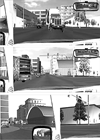NEUROPSYCHOLOGICAL PREDICTORS OF SAFETY IN URBAN LEFT-TURN SCENARIOS
- PMID: 27135059
- PMCID: PMC4850494
NEUROPSYCHOLOGICAL PREDICTORS OF SAFETY IN URBAN LEFT-TURN SCENARIOS
Abstract
Left turns at urban intersections can be dangerous, especially when views are obstructed or pedestrians are present. Impairments in driver vision, motor, and cognition functions may further increase left-turn risk. We examined this problem in a simulated environment that included left-turn scenarios to study the driving behaviors of 28 drivers, ages 37 to 88 years, six of whom had "Useful Field of View" (UFOV) impairments. Subjects also completed a battery of neuropsychological tests. The simulated drive included an urban section with six left turns in three types of scenarios: 1) a semi truck blocking the view of oncoming traffic, 2) a lead vehicle obstruction, and 3) a pedestrian crossing ahead of the turning driver. Results showed a mean (SD) of 1.46 (1.60) collisions per driver (range 0 to 7), 83% of which occurred at intersections with semi trucks. Far visual acuity, contrast sensitivity, UFOV, Mini Mental State Examination, Trail-Making Test Part B, the Wisconsin Card Sort task, and age were all associated with the total number of collisions (Pearson correlation magnitudes between 0.37 to 0.77; p-values<0.05). Spearman correlations were less significant. Findings indicate that visual obstruction by on oncoming semi-truck is a particularly dangerous left-turn situation.
Figures
Similar articles
-
Time-to-contact estimation errors among older drivers with useful field of view impairments.Accid Anal Prev. 2016 Oct;95(Pt A):284-91. doi: 10.1016/j.aap.2016.07.008. Epub 2016 Jul 26. Accid Anal Prev. 2016. PMID: 27472816 Free PMC article.
-
Older driver distraction: a naturalistic study of behaviour at intersections.Accid Anal Prev. 2013 Sep;58:271-8. doi: 10.1016/j.aap.2012.12.027. Epub 2013 Jan 18. Accid Anal Prev. 2013. PMID: 23332726
-
Impact of Oncoming Headlight Glare With Cataracts: A Pilot Study.Front Psychol. 2018 Mar 6;9:164. doi: 10.3389/fpsyg.2018.00164. eCollection 2018. Front Psychol. 2018. PMID: 29559933 Free PMC article.
-
Left Turns by Older Drivers With Vision Impairment: A Naturalistic Driving Study.Innov Aging. 2021 Aug 1;5(3):igab026. doi: 10.1093/geroni/igab026. eCollection 2021. Innov Aging. 2021. PMID: 34549096 Free PMC article.
-
How do drivers overtake pedestrians? Evidence from field test and naturalistic driving data.Accid Anal Prev. 2020 May;139:105494. doi: 10.1016/j.aap.2020.105494. Epub 2020 Mar 20. Accid Anal Prev. 2020. PMID: 32203729
Cited by
-
Driver Self-Regulation Practices in Older Drivers with and Without Mild Cognitive Impairment.Clin Interv Aging. 2020 Feb 14;15:217-224. doi: 10.2147/CIA.S236998. eCollection 2020. Clin Interv Aging. 2020. PMID: 32103924 Free PMC article.
-
Augmented reality cues to assist older drivers with gap estimation for left-turns.Accid Anal Prev. 2014 Oct;71:210-21. doi: 10.1016/j.aap.2014.05.020. Epub 2014 Jun 18. Accid Anal Prev. 2014. PMID: 24950128 Free PMC article.
References
-
- Andersen GJ, Enriquez Z. Aging and the detection of observer and moving object collisions. Psychology of Aging. 2006;21:74–85. - PubMed
-
- Ball K, Owsley C. Identifying correlates of accident involvement for the older driver. Human Factors. 1991;33:583–595. - PubMed
-
- Ball K, Owsley C, Sloane ME, Roenker DL, Bruniw JL. Visual attention problems as a predictor of vehicle crashes in older drivers. Investigative Ophthalmology & Visual Science. 1993;34:3110–3123. - PubMed
-
- Caird JK, Hancock PA. Left-turn and gap acceptance crashes. In: Dewar RE, Olson P, editors. Human factors in traffic safety. Tucson, AZ: Lawyers & Judges Publishing; 2002.
-
- Chan C, Ragland DR, Shladover SE, Misener JA, Marco D. Observations of driver time gap acceptance at intersections in left-turn across-path-opposite-direction scenarios. Transportation Research Record. 2005;1910:10–19.
Grants and funding
LinkOut - more resources
Full Text Sources


